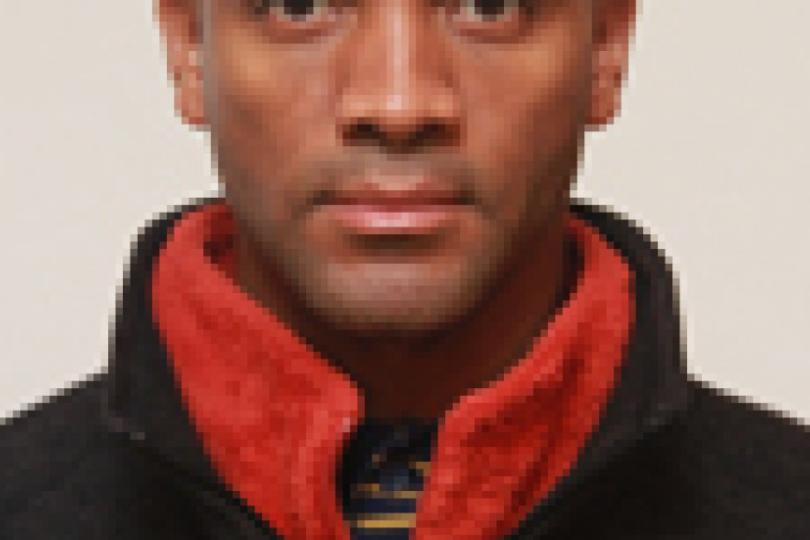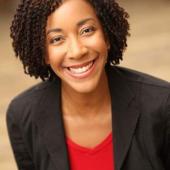20 QUESTIONS: Physical dance
Interview

Marciano Silva dos Santos loves Susan Boyle. He also happens to be the Artistic Director of Contempo Physical Dance, and the company name doesn’t lie. I left last spring’s show, SenZalma, blown away by the amount of strength, stamina, and artistry required to execute Marciano’s movement and narrative. We’re lucky he chose to call the Twin Cities his home.
(Seriously, though: he traded the tropics for six months in a parka. We are LUCKY.)
Name: My name is Marciano Silva dos Santos, a big name.
Occupation: I founded a company, Contempo Physical Dance. I work for Contempo for my [full-time] job, as well. I’m the Artistic Director for the company, and I teach at the U. I was teaching in the dance program over there, and now I teach in the BFA program with the University of Minnesota and the Guthrie Theater. It’s a great program, I love it. Sometimes I travel and teach residencies. I like working with younger [people] or professionals, because it helps develop my movement vocabulary, and helps [me] understand different bodies. I like to develop the movement on the dancer’s body. That’s why when I go to teach at a college or high school program, it helps me to develop my movement and understand others’ bodies, too.
Minneapolis or St. Paul: Well, I live in a suburb of St. Paul, and Contempo Physical [is in] St. Paul, but we perform the most in Minneapolis. Our rehearsals are here in Minneapolis, too, [while] we’re trying to find a place that can house Contempo Physical Dance in St. Paul. But if I had to choose…I don’t know. It’s different, because St. Paul is a quieter place, everything happens in Minneapolis, you know, so… I changed my mind, when I started living in St. Paul, because it’s [quieter], and I come from here [Minneapolis], from work, and there’s traffic, and I get there and rest. I fell in love with St. Paul. I love both cities, [but] I like St. Paul.
1) How did you end up doing the work you do? So first, my Portuguese teacher in my high school, she [noticed] me in her class. When we talked about text, about movement behind the text, I was so deep into it because…I don’t know why. She came to me and said, “Marciano, have you ever thought about doing theater or something?” I was so shy, I couldn’t do that. She said, “I think you should.” So she showed me how, downtown, [in] my city, there was a school that had a program in dance and theater. She took me to apply for this school. I said, “Ok, I’ll try.” I went there to apply, I passed the test, and I studied theater over there, and it was a great program.
At the end of the theater program, we had a showing. And the teacher gave me- I don’t know if you know Frederico Garcia Lorca’s Blood Wedding. I did the Moon character. It was a lot about expression, big [speeches], and you had to coordinate the speech and your body. It was an amazing process. After I did this and created this character, I had so many choreographers and teachers in the audience, and one of these choreographers came to me and said, “Marciano, have you ever thought about being a dancer?” I said, “No,” because I wasn’t studying to be a dancer, I was studying theater, because I fell in love with theater. Again, he told me I should research more about the body, because my body could be a resource for dance. I said, “Ok,” and he invited me to come to his dance company, to see if I liked it.
I went there, to visit his dance company - his name [was] Jou Mendes, a Brazilian choreographer, a late Brazilian choreographer. I saw those dancers jumping, running here, going there, so many different movements. I thought, I cannot do that. I was scared because it was my first time, you know, the first impact when you see the work. He said, “No, I think you should try. Go and try and see what it is for yourself.” I said, “Ok,” [and] I started doing that. I did an internship with them, going to the technique classes, and after six months I thought, Wow. I love doing that. I fell in love with the way your body responds to the process of dance work, and I started doing some work for them. After that, so many invitations came in for other dance companies, for me to be a guest artist. I was doing it because I liked to learn a lot. I learned so many [techniques]: ballet, contemporary, capoeira; capoeira is martial arts in Brazil.
I worked with [a company] and there, one of the dancers came to me and said, “You don’t count. Your counts are wrong.”
I thought, How are they wrong? I don’t know. Something didn’t match with my counts. Interesting. I was like, Mm, yeah. I’m going to find out about that.
After [I researched] my movement, the choreographer came to me and said, “I can tell your body doesn’t count right.” I said, “No, I sing the movement.” I don’t say, “One, two, three, four.” I sing the movement right away. When it shows me something, I design the movement, design the rhythm right there, and try to incorporate it into my body. That’s how I started doing my work, to research that. I studied that. That’s the thing that brought me…to develop my movement vocabulary. I was [deeply interested in knowing] how to understand that, how to pass that on, how to teach that, and it wasn’t easy, because I was trying to develop my body first, to see what it is.
[After I arrived in the US] I didn’t have time to see anything. My wife [brought] me [from] the airport, threw me into rehearsal with TU Dance, without speaking any English. It was a shock for me. But I’m an observant guy. I learn fast, observing, [but] it was a hard process at that time. After that, I worked with TU dance, [and] I sent a proposal to the University of Minnesota to teach in the dance program. They invited me, and I was teaching with them for six years.
When I was working with TU Dance, I was searching for something. I didn’t know if I just wanted to be a dancer. I [wanted] to be something else. Something was pushing very hard for me to create something, and after that I started researching. I was researching, I was working with TU Dance. They invited me to be a dance teacher, teaching class for the company. At that moment, I was looking for something that I could develop. I heard about the Ritz Theater. I think it was the first Ritz Theater Renovate that I participated in. I sent a proposal, I auditioned, I was accepted, I did my work. I [hired] some dancers to try out my movement. It was a great experience. I created the work, I showed that, and people loved it.
I wanted something more than that. I heard that NEFA [New England Foundation for the Arts<] was in partnership with The Cowles Center and was having this program [the Regional Dance Development Initiative], original arts development for New England Foundation for the Arts. I sent my proposal, it was selected. I went to St. Benedict with 10 new emerging choreographers. I think it was 2009. And there I learned a lot about how to develop your work, how to talk about the work, what it is you’re looking for. I was studying so much.
At that time, I was working for TU Dance. TU Dance knew…that I was searching for something else. They said, “Marciano, if you leave, just give us one year, after that you can go.” I gave my word, said, “Yeah, that’s all fine to me.” But when I left from [St Benedict], when I finished this program, out here, I went to my wife, Jenny, and said, “I want to get Contempo Physical now, a company right now.” I said, “I have to develop this now, otherwise, I’m not going to create anything else.”
She trusts me, and she said, “Yeah, I want to help you. When do you want to start?”
I said, “I think I’m going to start now.” I went to TU Dance, they understood about letting me go, to find my way.
Day by day, writing - my English was so poor at that time - and how to write in English [and] in Portuguese, and [showing] Jenny, and Jenny saying, “Ah, I don’t understand, write it again”; that moment to develop Contempo Physical, what it is, that helped me a lot to develop. That’s the way I started getting into the work, that’s how I came to this point.
2) Who’s/What’s your nemesis? Why? I hope I don’t have one! I think my enemy is believing too much. Because I try to help, when I go to rehearsal, technique class, for example, with my company, I see the dancers, I have [so much] hope for them. Oh gosh, I really- I could help them more, so much more [so they] can go beyond Minnesota. I think what it is- I don’t have one, but I think enemies could be like that.
3) How long have you lived in the Cities?/What brought you here? I met my wife, Jenny Pennaz, she was studying abroad in 2000? 2001, maybe? I was one of the dance teachers in this program to teach American students in my city, [at] the University of Espirito Santo. She took my class, and she came to me - I did some showing for her, for the students - [and] she said, “Oh, my gosh. I think Minnesota’s going to like you.”
I said, “Really?”
She said, “Yeah, I think you should come.” She told me a little bit about Minnesota, she said it was very cold. My city has very tropical weather, and I said, “I don’t think so. I think I’d like to be here. I have work here.” You know, I wasn’t used to leaving the country.
She said, “I think you should try.”
She got back here [to Minnesota], talked to so many people, and tried to bring me here. She was teaching ballet, [and] the only guy in the ballet class, he was an immigrant lawyer, and she took my story to him. He was joking, “You want to bring him just to dance, or something else?” She said, “Both.” He said, “Yeah, I can help you.” He helped me to [come] here, and I also came to dance with TU Dance, but they didn’t have power to bring me here at that time, because it was the beginning of the company. This lawyer helped to bring me here.
I came in 2006, after I was recognized by the American Folkloric Society as exceptional in merit. When I got here, I fell in love with the city. I thought everybody was an artist. It was my first expression about the Twin Cities.
4) Preferred place to be if you’re alone and incapacitated? In my city, Victoria, the capital of my state, Espîrito Santo. It recharges my body, my spirit, my human being.
5) How often do you call home? I used to call a lot, but now I’m so busy! I could say, twice a month, it’s not a lot, but that’s the time I have to call them. Sometimes I’d prefer to see them personally, better than calling, but the answer to your question is twice a month.
6) Best performance space in the Twin Cities? Why? Well, I would say the Cowles Center stage. It’s a beautiful stage, beautiful place, because they host us a lot. It’s a beautiful place to perform, but I also have performed, as well, at the Ordway Theater. It’s a big stage. If I have to choose… It depends on the kind of work you create, you match that space. I would say Cowles Center and Ordway Theater.
7) Favorite performer, living or dead? Why? Susan Boyle. [Interviewer: Susan Boyle? Really? The English woman? The singer? Why?] I fell in love with her story. I usually don’t watch Britain’s Got Talent, but for some reason, one of my friends on Facebook, they posted [it], and I decided to open it, and I was watching, the way she walked in; she’s old, nobody believed that she would open her mouth and put that voice out. She was telling her story of why she was so late in becoming a singer. Her mom said, “One day, no rush, people are going to see you.” And that moment was… my spirit… goosebumps… That was how the world was supposed to see it, something new. That’s new, you know, that’s not [something you see], usually.
8) Most hated dessert? Wow… [long pause] I would say apple pie.
9) What annoys you about the Twin Cities arts scene? I would say, writing grants, they have those questions? You have to answer this question every… All the time, when you’re going to write a grant, you have to answer [the same question] over and over again. I think if [there was some way] to respond to that, when you get the second one, people - I don’t know - have something that can help us to- otherwise, you’re getting stuck. But the questions [are] brilliant. [They] help us, really, think so hard to answer those questions.
10) Arts awards shows and/or “best of” lists in the Twin Cities: go. Well, I like [the] Sage Awards, because I’ve been on the panel before. I think it’s a… It’s nice, especially [in] the Twin Cities, having so [much] talent, it [makes us] proud. I think they make the panelists see everything. There are so many different categories. I think that helps to develop [or let artists be] recognized for their work.
11) Donuts: awesome or overrated? I got used to donuts when I moved here, so I was like, I fell in love with donuts. I was eating a lot. But now, I hate [them].
12) Best thing about the Twin Cities arts scene? I would say the community. Somehow, I think…magic… I’ve been in different cities and states in the United States. For some reason, I can see magic; something’s happened here that’s very strong, very strong. The community supports artists and supports young or old or middle aged and older to be involved in the arts, and also give you the chance to develop something.
13) What song or songs best describe your life? Wow…I would say Enya. I go listen to my CD [of] Enya a lot; especially to able to think, to go to sleep, to calm down, to help me to [be] on my own to see what’s going on and move on.
14) Out of any living Minnesotan, who would you pick as the next Governor of Minnesota? Why? Well, I’m not [really] involved in political things. I wish - I don’t know a lot about the government here - but I wish it could be someone very close to the culture. You know what I mean? That could understand that, make more programs accessible to artists, to [the] community, and, yeah… People can move closer to the arts. [Interviewer: Is there anyone that you can think of that would be good at that?] Not for now. I will do some research.
15) Spring, Summer, Fall, or Winter? Well, I love summer. Summer, yeah.
16) Favorite adult beverage? I’m a wine guy. Sometimes I do some beer, but I like wine.
17) Pajamas: necessary or a waste of laundry space? Waste, yeah.
18) Favorite “luxury” item with which to treat yourself? I would say shoes. I think when I see [something I like], I say, “Oh my gosh, I want to try that.” Sometimes, it’s a waste of money. You don’t need it. You buy it because, you know. I learned from that, I don’t do it anymore, but I used to do that.
19) What rituals do you have concerning your work?/How do you prepare? Depends. I think, for me, it depends on the work I’m going to do, especially for my dance company, Contempo Physical Dance. Each work is [a] particular feeling for me. I [put] myself into the creation of this particular work, what I’m going to do, start my research, study my feelings, how I’m going to research to create that, [what] music, [what] costume. For me it just depends.
20) You have $500,000 to spend on whatever you want, as long as it’s not on something personal. What would you do with it? Wow, that would be awesome. First, I would help Contempo Physical Dance match the grant from Knight Foundation we got this year, and also [get another] place, a place that can house Contempo Physical, that the dancers- [someplace that] can be a better place for them to develop their careers. Also pay the dancers more, because they deserve it, because they work so hard, especially as they work to develop this kind of Brazilian movement style, and also my movement research; they work hard to understand that. I think I’d help a lot to develop all of these dancers, be paid more, develop a place where the company can rehearse, and also help others who [don’t] have money to pay for class come take class for free, and to teach them and help them discover themselves in the world, in the dance world. I think I would use this money to do that.
You can see Contempo Physical Dance next at The Cowles Center for Dance and the Performing Arts January 30 - February 1, 2015 with Motirô.




